June 2022
June 4 Biking through the Arboretum this morning, spotted this kousa dogwood tree, with its wonderfully patterned leaves.
 |
| Kousa dogwood |
Also saw this guy wheeling a harp through the Arb; he told me his wife was playing at a wedding.
 |
| Harp on its way to a wedding |
Later on in the morning, at the Roslindale outdoor market, open for the first time this season, loved seeing this mushroom stall.
 |
| Roslindale farmers market |
June 6 On a morning bike ride to MIT, saw hundreds of plants being unloaded from a tractor trailer, along the edge of Leverett Pond. Over the last couple of years, the US Army Corps of Engineers has been dredging and upgrading the pond, as well as the Muddy River that flows from it. They're now putting the finishing touches of plantings! I can't wait to see it all done.
 |
| Plantings waiting at Leverett Pond |
On the way home, I get a glimpse of a great blue heron through the trees and when I take a closer look, I see that it's perched on top of a wood duck nesting box. And as I'm taking photos, I see tree swallows (I think) dive bombing it, forcing the heron to duck to avoid them. Pretty amazing. I'm always impressed by the audacity of tiny birds to attack much larger ones. Tree swallows are about 5" long and weigh about 3/4 of an ounce; great blue herons are about 45" long and weight about 5 pounds.
Later on, I go with my new friend Susan to see the red-tailed hawk nest. One of the juveniles is out of the nest, perched on the steel framework holding the nest, while the other is standing on the nest. The one out of the nest hops onto it and pokes around at the nest with its bill. They're both starting to move around more, spreading their wings, looking like they're going to try flying soon. Amazing to see how quickly they've grown. On May 13, they were just little grey fluffballs. They stay on the nest for about 6 weeks before fledging, according to the Cornell All About Birds website. Neither adult is on the nest; I think as the juveniles get bigger, it takes both adults to capture enough prey to feed both of them.
 |
| Both juvenile red-tails on the nest |
Also saw a pair of wood ducks paddling across Leverett Pond and a great blue heron preening in a tree on one of the islands near the footpath.
June 8 Only one juvenile hawk left at the nest.
Drove to Hog Island, about an hour north of Portland, Maine, to give a talk on feathers for the National Audubon summer bird camp. The (adult) camp does guided bird walks during the day and talks on birds in the evenings, which is where I come in. The island itself is just a couple hundred yards off the mainland, a few minutes in the camp skiff. At the dock, there's an osprey nest on a scaffold installed for that purpose on top of the boathouse. When I arrive in the late afternoon, an osprey is flying back and forth over the nest, screaming. The boatman told me that last year, a pair of bald eagles hung around this area, waiting until the juveniles were about to fledge before killing them. Yikes.
 |
| Osprey nest |
Hog Island is on the right in the photo below. On the ride over, I spot a couple of guillemots along with a seal. At the camp, a hummingbird, presumably a ruby-throated (they're the only ones that live in Maine), is zipping about the flowering shrubs. Laughing gulls, with their black heads, flying over the ocean, near the island.
 |
| Hog Island, Maine |
The group loves my talk (Fantastic Feathers: Form and Function) and I love that the room has a gannet "flying" from the rafters. I'm lucky that Ian Owens, the new Director of the Cornell Lab of Ornithology, is at Hog Island and comes to listen to my talk. I'm tickled that he said it was "excellent" and invited me to give a talk at Cornell.
 |
| Northern Gannet at Hog Island lecture room |
The only disappointment is that the boat outing to see puffins was cancelled due to bad weather.
June 11 I go with Susan to a new place that friends recently told me about: the Wakefield Estate in Milton, "the culmination of three centuries of use by eight generations of a single family", settled in 1706, as the brochure says. Now, it's a botanical garden, with a formal garden, a rose garden, a kalmia garden with 4 dawn redwoods (the symbol of the Arnold Arboretum). I'm here to see the kousa dogwoods that Mary Wakefield propagated from seeds from the Arnold Arboretum. There are dozens of them, all covered in creamy white blossom, collected together in a single field.
 |
| Kousa dogwood |
June 11 No hawks at the nest; both the juveniles have fledged.
June 14 Getting my breakfast ready, I spot a squirrel perched in one of the "woolly pockets" on the garage, where Jeannie used to plant annuals (I've given up on this as they tend to fry in the heat).
And after I'm done eating, I notice that it's actually made itself quite comfortable and has fallen asleep, with its tail curled up around it, in one of the other pockets. As I sneak up to get a photo, it wakes up and checks me out.
June 15 On a walk around the pond in the late afternoon, lots of tree swallows, flying low over the water along the bank of the pond, catching insects. Love the gleam of their metallic blue backs. Then I spot what I think is a juvenile great blue heron perched on a rock near the edge of the pond.
 |
| Juvenile great blue heron (?) |
At one point, I notice a downy woodpecker land on a tree trunk and start probing the crevices for insects. As I'm watching it, I hear a commotion, and look up to see a Baltimore oriole screeching in the same tree, flitting from branch to branch, then chasing a grackle.
June 16 Spotted a red-tailed hawk perched on a branch near the boathouse on my morning walk with Maddie. A mockingbird was harassing it, flying right into its belly and back, darting at its head, but the hawk ignored it and just stayed put. A second mockingbird joined in for a bit, then a blue jay, too. But the hawk wasn't impressed with their efforts. On the way home, I ran into my neighbors Mary and David, who said that they'd seen a hawk with a young squirrel in its talons at the pond this morning, too. I wonder if it was the same one.
Went to Wachusett Meadows in central Massachusetts for an Audubon meeting this afternoon. The property was farmed from the late 1700s until it was donated to Mass Audubon in 1956. In the first half of the twentieth century, it was famous for its shorthorn dairy cows. The farm pond has a huge beaver dam; one of the staff told me it's been there for 20 years and the beavers have now moved on to another area. As we were talking, lots of birds: tree swallows, barn swallows, downy woodpecker, hawk mobbed by the tree swallows.
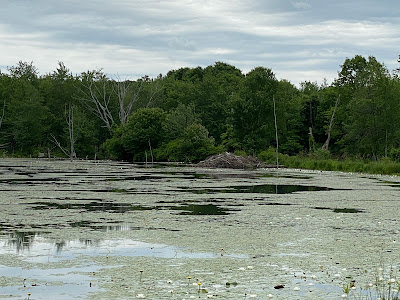 |
| Beaver lodge at Wachusett Meadow |
June 17 In Provincetown for the weekend visiting Susan, walking around town, went to the library. Built in 1860 as a Methodist Episcopal church, seating 900, over the years it was converted into a museum, including a heritage museum, at which point this half scale schooner was built into the building.
 |
| Provincetown library |
June 21 Back in JP, out with Maddie early, a single enterprising house sparrow, in the midst of a gaggle of Canada geese on the grass by the pond, is collecting down in its beak.
Later on in the morning, I visited Mass Audubon's Museum of American Bird Art in Canton, just south of Boston. One of the Audubon staff there, Sean Kent, immediately pointed out an Eastern phoebe nest in the eaves of one of the buildings and sent me some of his photos.
 |
| Adult Phoebe, Sean Kent |
 |
| June 7 eggs, Sean Kent |
 |
| June 8 first hatching, Sean Kent |
 |
| June 13 fuzzy phoebes, Sean Kent |
 |
| June 17 feed me phoebes, Sean Kent |
 |
| June 19 ball of phoebes, Sean Kent |
The property was previously owned by a nature artist; her bright, high ceilinged studio became the museum's gallery. Currently, the bird art is in storage, awaiting installation at a building being renovated at a new sanctuary. The former gallery space has now been converted into a "maker" space, with a laser cutter capable of cutting sheets of everything from mylar to thin plywood, as well as several other cutters. They also do print making and have a kiln for firing ceramics.
 |
| The maker space |
 |
| Turtle and owl cut outs made with the cutter on the table |
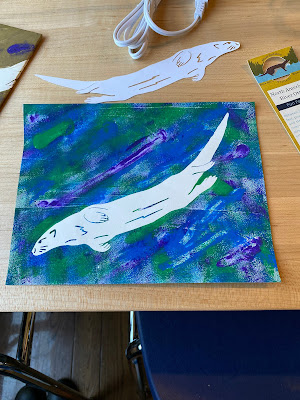 |
| Otter stencil |
In the afternoon, talked with Mya Thompson at the Cornell Lab of Ornithology about giving a talk for their ornithology seminar in the fall, as well as other possible collaborations. Very exciting!
In the evening, went for a bike ride: great blue heron at Leverett Pond and black-crowned night heron perched on a downed branch over the Muddy River.
June 24 Early morning birding at Plum Island, on the north shore, with a few Mass Audubon staff and a couple of friends of Mass Audubon. A little cloudy at first, then clearing up, still a little crispness in the air. First stop: the purple martin nest condos where the martins were zipping in and out of the nests, feeding their young. One flew away, dropping a fecal sac as it left: some nestlings excrete waste in a membrane that is then removed from the nest by the adults. One of the guys in the group said he wished his kids did that when they were little.
 |
| Purple martin nests |
At the edge of the marsh near the martin nests, an osprey flew past with a fish in its talons, turned to face forward to be aerodynamic. Another osprey on a nesting platform further into the marsh. Great egrets and snowy egrets flying overhead, standing in the shallows of the marsh, lots of them all over the place.
As we drove along the roadway, we passed a Motus tower, set up to pick up radio transmittter signals from birds flying overhead.
 |
| Motus tracking station |
Birds Canada operates a network of these towers across North, Central and South America, allowing birds to be tracked as they migrate. Tiny nanotag radio transmitters, weighing as little as 0.15grams, can be used even on small birds (as a rule of thumb, devices attached to birds must be less than 4% of the weight of the bird). For instance, a black-capped chickadee (the state bird of Massachusetts) weighs about 10 grams (about 1/3 of an ounce), so that any device attached to it must weigh less than 0.4 grams.
Baltimore orioles in the reeds and flying over the marsh. An orchard oriole picking off something at the top of a tree. Several yellow warblers futzing in bushes. Mute swans with fuzzy grey cygnets snoozing on a sand flat in one of the ponds. Willets flying over the inlets and probing the sand at the edge of the marsh. A gadwall puttering about in one of the ponds; one of the Audubon staff said that they nest there. A Cooper's hawk flying overhead, being mobbed. A least tern flying over the roadway, heading for the ocean side of the sanctuary. A few of the people in our group saw a least bittern, but I missed it. And one of the Audubon staff thought she saw a mink run along the edge of the marsh. Fun to be with a group of enthusiastic birders, just out enjoying the beauty of the place and the day.
 |
| Plum Island |
June 26 Morning walk at the Arboretum, saw this unusual clematis, an alpine clematis, with silvery, fibrous balls all over it.
 |
| Alpine clematis |
June 27 Great blue heron fishing at the pond, just along from the boathouse this morning.
 |
| Great blue heron |
During a morning rain, saw a squirrel taking shelter in the wooly pockets on my garage wall beneath the eaves.
June 28 Cedar waxwings at the pond in the morning, darting out over the water, catching insects, then landing on the trees at the water's edge.
Riding my bike by Leverett Pond, I saw the plantings that had been done over the last week or two - all looking good. The workman I spoke to said they hoped to have it all finished up, fencing and everything, in about 3 weeks.
 |
| Finished plantings at Leverett Pond |
Then along the Esplanade, by the Charles River, saw these juvenile mute swans but didn't see the adults. I later found this article saying that two adult swans along the Esplanade had avian flu and had been captured and euthanized the day before. The 5 cygnets, I'm assuming the same ones in the photo, were taken to a wildlife rehab facility the next day.
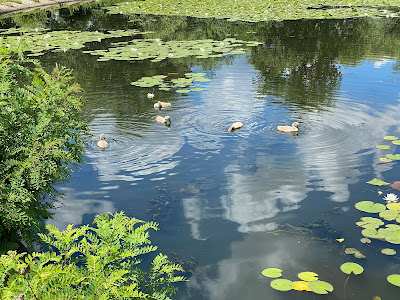 |
| Cygnets at the Esplanade |
June 30 In Provincetown visiting Susan, we went on a bike ride to Truro.
 |
| Cold Storage Beach, Truro |
Stopped for a picnic lunch and watched starlings flying in to feed their young at a nest inside a 90 degree bend in a white plastic pipe running up the wall of a building. Also saw a lightning fast male house sparrow mounting a female - the entire act lasted all of about 2 seconds.
July 1 Sitting on the deck, Susan spotted a male eider duck, looking a bit bedraggled, swimming close to the shore. I wondered if it had the same avian flu that the Esplanade swans had.
 |
| Provincetown beach |
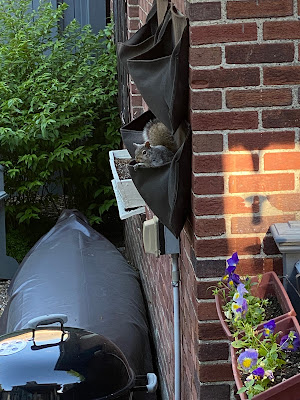
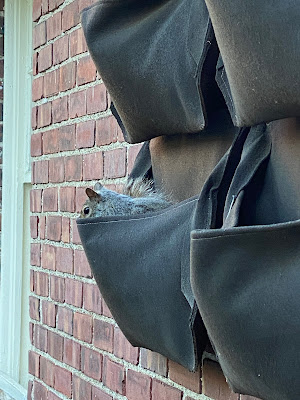




Comments
Post a Comment